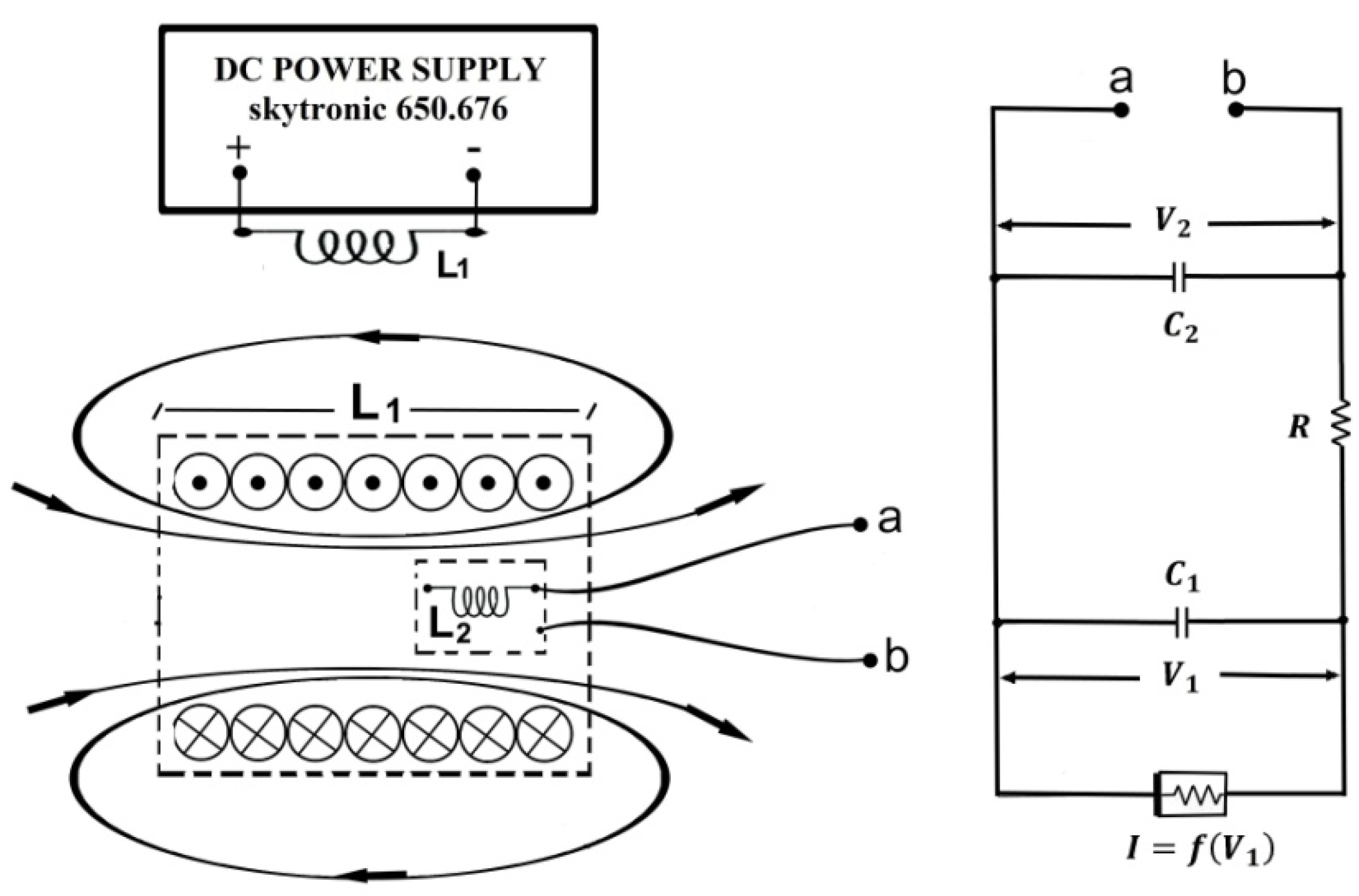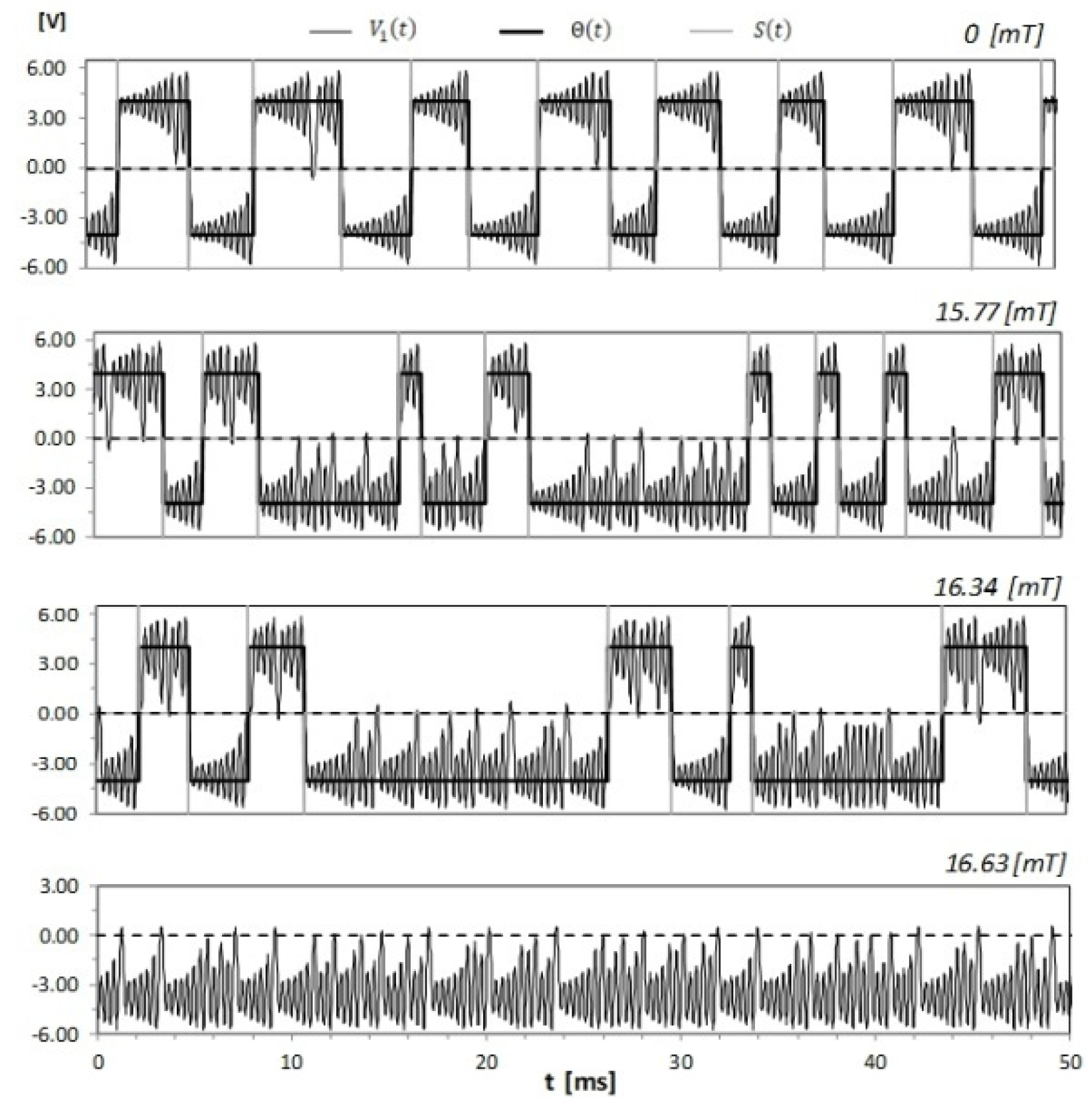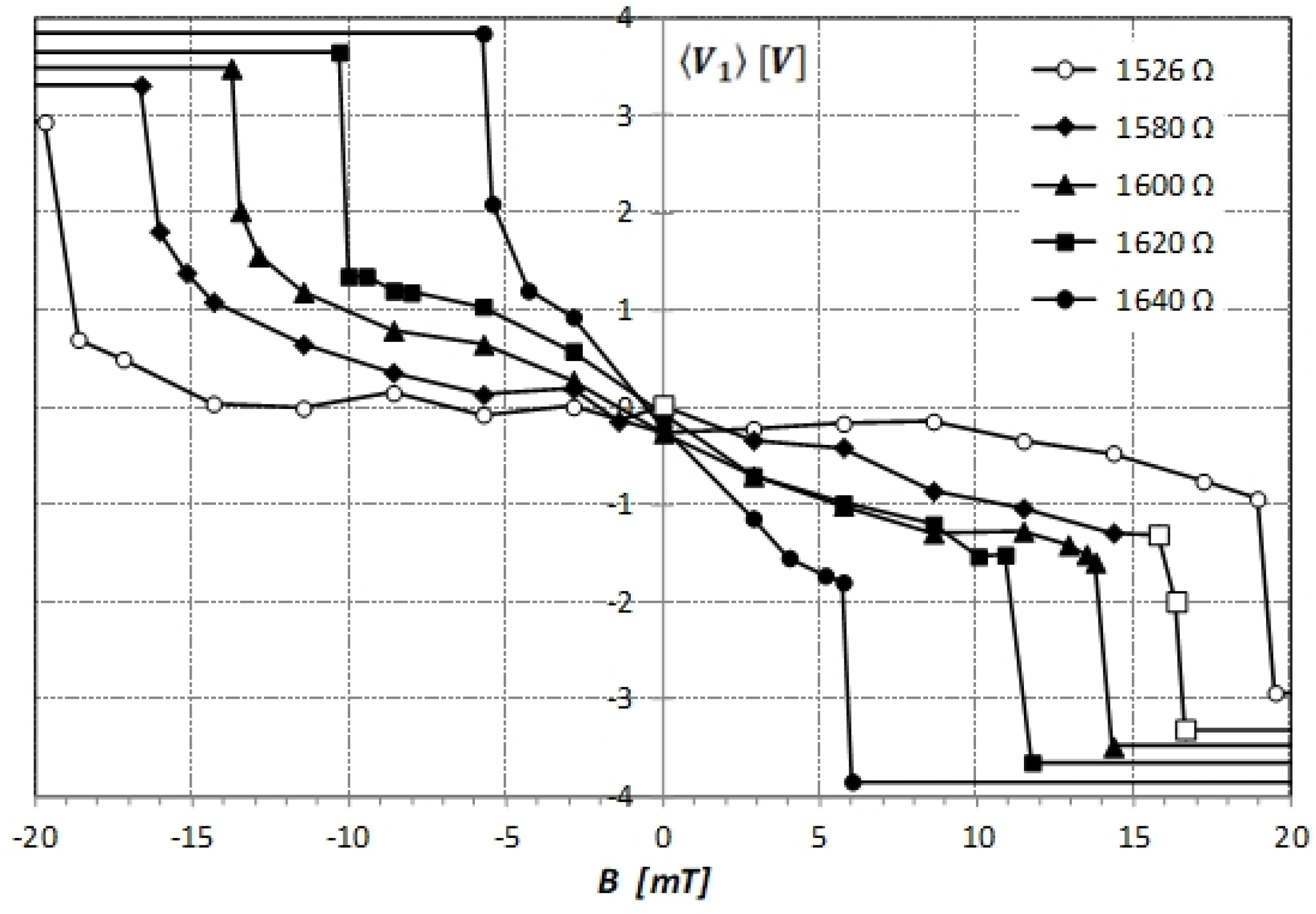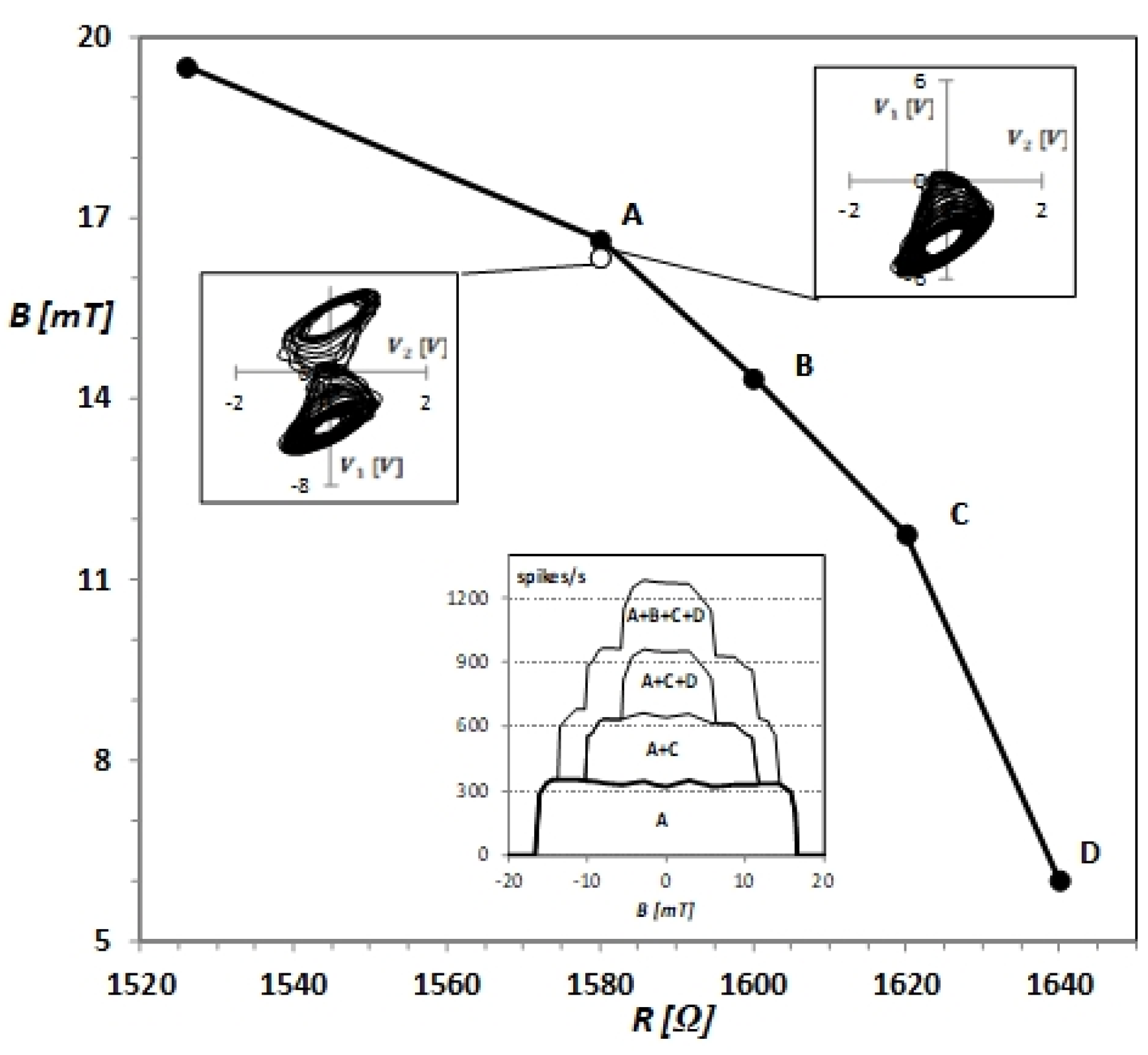Biomimetic Chaotic Sensor for Moderate Static Magnetic Field
Abstract
:1. Introduction
2. Materials and Methods
3. Results and Discussion
4. Sensor Proposal
5. Conclusions
Author Contributions
Funding
Institutional Review Board Statement
Informed Consent Statement
Data Availability Statement
Conflicts of Interest
References
- ICNIRP. Guidelines on limits of exposure to static magnetic fields. Health Phys. 2009, 96, 504–514. [Google Scholar] [CrossRef] [PubMed]
- Zhang, X.; Yarema, K.; Xu, A. Biological Effects of Static Magnetic Fields; Springer Nature: Singapore, 2017. [Google Scholar]
- Kesić, S.; Nikolić, L.; Savić, A.G.; Petković, B.; Spasić, S.Z. Ouabain modulation of snail Br neuron bursting activity after the exposure to 10 mT static magnetic field revealed by Higuchi fractal dimension. Gen. Physiol. Biophys. 2014, 33, 335–344. [Google Scholar] [CrossRef] [PubMed] [Green Version]
- Lenz, J.; Edelstein, A.S. Magnetic Sensors and Their Applications. IEEE Sens. J. 2006, 6, 631–649. [Google Scholar] [CrossRef]
- Gomes, I.; Korneta, W.; Stavrinides, S.G.; Picos, R.; Chua, L.O. Observation of stochastic resonance for weak periodic magnetic field signal using a chaotic system. Commun. Nonlinear Sci. Numer. Simulat. 2021, 94, 105558. [Google Scholar]
- Tsai, F.-W.; Yu, T.-P.; Lu, M.-C.; Chan, C.-A.; Zhong, Y.-L.; Tsai, T.-Y.; Hsu, C.-S.; Tsai, T.-L.; Liu, C.-J.; Ho, M.-C. Phase Synchronization Underlying the Mutual Inductance Effect on Chua’s Circuits. Sens. Mater. 2019, 31, 2415–2424. [Google Scholar]
- Antonovich, M.V.; Druzhina, O.S.; Serebryakova, V.O.; Butusov, D.N.; Kopets, E.E. The Analysis of Oscillations in Chaotic Circuit with Sensitive Inductive Coil. In Proceedings of the IEEE Conference of Russian Young Researchers in Electrical and Electronic Engineering (EIConRus), Saint Petersburg and Moscow, Russia, 28–31 January 2019; pp. 61–65. [Google Scholar]
- Hu, W.; Liu, Z. Study of Metal Detection Based on Chaotic Theory. In Proceedings of the 8th World Congress on Intelligent Control and Automation, Jinan, China, 6–9 July 2010; pp. 2309–2314. [Google Scholar]
- Karimov, T.; Nepomuceno, E.G.; Druzhina, O.; Karimov, A.; Butusov, D. Chaotic Oscillators as Inductive Sensors: Theory and Practice. Sensors 2019, 19, 4314. [Google Scholar] [CrossRef] [PubMed] [Green Version]
- Chua, L.O. The genesis of Chua’s circuit. Archiv. Elektron. Ubertrag. 1992, 46, 250–257. [Google Scholar]
- Sprott, J.C. Some Simple Chaotic Flows. Phys. Rev. E 1994, 50, R647–R650. [Google Scholar] [CrossRef] [PubMed]
- Karimov, T.; Antonovich, M.; Mashanin, A.; Yastrebkov, A.; Slizh, A. Synthesis of chaotic circuits with inductive elements based on 3rd order differential equations. In Proceedings of the IEEE Conference of Russian Young Researches in Electrical and Electronic Engineering (ElConRus), Saint Petersburg and Moscow, Russia, 28–31 January 2019; pp. 89–92. [Google Scholar]
- Teodorescu, H.N. Modeling natural sensitivity: A-Life sensitive selective sensors. J. Biomed. Fuzzy Hum. Sci. 2000, 6, 29–34. [Google Scholar]
- Ando, B.; Baglio, S.; Bulsara, A.R.; Sacco, V. Residence time difference fluxgate magnetometers. IEEE Sens. J. 2005, 5, 895–904. [Google Scholar] [CrossRef]
- Gammaitoni, L.; Bulsara, A.R. Noise activated nonlinear dynamic sensors. Phys. Rev. Lett. 2002, 88, 230601. [Google Scholar] [CrossRef] [PubMed] [Green Version]
- Teodorescu, H.N.; Hulea, M.; Cojocaru, V. Characterizing the attractors of chaotic systems by a direct measurement method. In Proceedings of the 18th International Conference on System Theory, Control and Computing (ICSTCC), Sinaia, Romania, 17–19 October 2014; pp. 494–500. [Google Scholar]
- Korneta, W.; Gomes, I.; Picos, R.; Zábovský, M. Nonlinear Sensor Driven by Chaotic Dynamics. In Proceedings of the ANNA ‘18—Advances in Neural Networks and Applications, St. Konstantin and Elena Resort, Bulgaria, 15–17 September 2018; pp. 44–47. [Google Scholar]
- Kreiman, G. Neural coding: Computational and biophysical perspectives. Phys. Life Rev. 2004, 1, 71–102. [Google Scholar] [CrossRef]
- Matsumoto, T.; Chua, L.O.; Komuro, M. The double scroll. IEEE Trans. Circuits Syst. 1985, 32, 797–818. [Google Scholar] [CrossRef]
- Ayrom, F.; Zhong, G.-Q. Chaos in Chua’s circuit. IEE Proc. D—Control. Theory Appl. 1986, 133, 307–312. [Google Scholar] [CrossRef]
- Kennedy, P. Robust op amp realization of Chua’s circuit. Frequenz 1992, 46, 66–80. [Google Scholar] [CrossRef]
- Gomes, I.; Mirasso, C.R.; Toral, R.; Calvo, O. Experimental study of high frequency stochastic resonance in Chua circuits. Physica A 2003, 327, 115–119. [Google Scholar] [CrossRef] [Green Version]





Publisher’s Note: MDPI stays neutral with regard to jurisdictional claims in published maps and institutional affiliations. |
© 2021 by the authors. Licensee MDPI, Basel, Switzerland. This article is an open access article distributed under the terms and conditions of the Creative Commons Attribution (CC BY) license (https://creativecommons.org/licenses/by/4.0/).
Share and Cite
Korneta, W.; Gomes, I.; Picos, R.; Zábovský, M. Biomimetic Chaotic Sensor for Moderate Static Magnetic Field. Sensors 2021, 21, 6964. https://doi.org/10.3390/s21216964
Korneta W, Gomes I, Picos R, Zábovský M. Biomimetic Chaotic Sensor for Moderate Static Magnetic Field. Sensors. 2021; 21(21):6964. https://doi.org/10.3390/s21216964
Chicago/Turabian StyleKorneta, Wojciech, Iacyel Gomes, Rodrigo Picos, and Michal Zábovský. 2021. "Biomimetic Chaotic Sensor for Moderate Static Magnetic Field" Sensors 21, no. 21: 6964. https://doi.org/10.3390/s21216964







